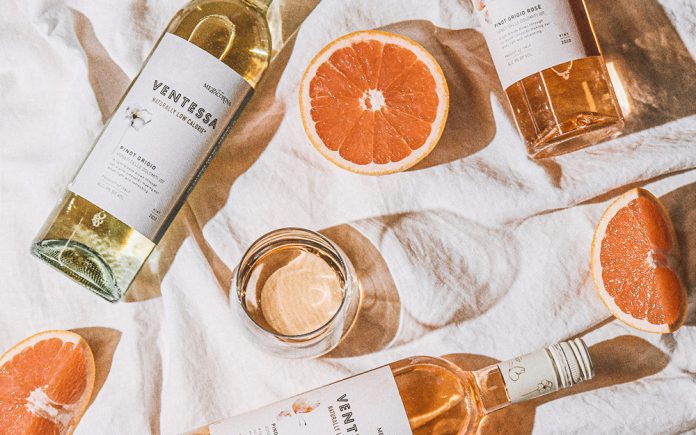
By Rick Riozza
Nope! On your mark, get set, GO! In the brave new world of the wine game, the drinking patterns of the new wine enthusiasts and health-minded quaffers are seeking low calorie and low alcohol wines to meet their desires to live a “better” life.
Theology aside, I guess a “better” life consideration is that, when it comes to weight loss, alcohol is considered “empty calories” since it doesn’t contribute to one’s daily requirement of nutrients and vitamins necessary for proper health. We’ve all heard it: Too much alcohol is also linked to an increased risk for a slew of diseases, so most doctors will tell you to keep your intake limited, even when you’re not counting calories.
And ask any health professional these days, if you desire to diet or detox, one must unfortunately realize that your favorite alcoholic beverage is on the list to avoid. Of course they must be talking about heavy spirits—heavy IPAs; they’re not referring to our cherished wines, are they?
Haven’t we believed since Biblical times, a glass of wine is good for the body? We read the health benefits, particularly red wine which contains a key antioxidant called resveratrol, which has been found to actually prevent various conditions, including heart disease and even some forms of cancer.
This debate can get heavy and is best left for the medical journals. We’re just writing a simple wine column here in the desert, and, the noticeable wine craze in our desert wine markets, are low-calorie/low alcohol wines. And it’s definitely an attractive beverage—especially for the wine enthusiast, when you compare it to the other most popular beverage in town: the hard seltzers with their accompanying fruit flavors.
Okay then. The Web notifier, Good to Know, concisely states. “Calories in wine come in two guises. Those in the alcohol: each gram of alcohol contains seven calories. And those in the sugar that’s either a leftover from the fermentation process or in the case of some wines, such as champagne, added after to give the wine a sweeter flavor.
“Some wines are very calorific, so even just a few glasses soon add up. One standard-sized glass of wine typically contains about 130 calories. Thus, “drinking four bottles of wine a month adds up to a yearly consumption of around 27,000 kcal, which is equivalent to eating 48 Big Macs per year.” Nothing like melodrama over at Mickey D’s.
So Lo-Cal/Lo-ABV wines begin with grapes from cooler regions; they’re naturally lower in sugar. The winemaker further harvests the wine grapes early to prevent over-ripening, which limits their sugar content. The sugar in the wine gets reduced by complete fermentation. The yeast consumes this sugar, leaving minimal to zero residual sugar. Finally, the winemaker performs reverse osmosis or spinning cone filtration to remove excess alcohol from the wine, resulting in a low calorie wine.
While low-cal wines have no set industry standard, they are generally at least 15% lighter than the standard 120 to 130 calories found in a 150ml serving. Some wines are carried on this trait alone, pitched as ‘skinny’, while others by virtue of their lower alcohol content are naturally lower in calories. Getting a balance between the alcohol content and resulting calories is the trick.
The Lo-Cal/Lo-ABV markets is increasing as we write. Be assured we’ll be granting more and more coverage as we sample the new market out there.
But now it’s time for this column to get on board stat! So—as we’re wont to do, and I’m sure it’s no surprise to you loyal readers, let’s start sampling first and foremost the top Lo-Cal/Lo ABVwine from—you guessed it! Italy
Enter now, the famed Italian wine producer, Mezzacorona as it introduces its first naturally Low-Calorie, Low ABV wine: Ventessa Pinot Grigio ($12) and Ventessa Pinot Grigio Rosé ($12). Each expression is only 90 calories/5 oz. serving, gluten-free with no additives or additional sugars. For more information, please visit www.ventessa.wine.
Gruppo Mezzacorona states: “Wine drinkers are in search of less alcohol in their beverages without sacrificing flavor, we now present a masterfully crafted Italian wine: Pinot Grigio found its ideal home in Trentino, and we are excited to bring these expressions to those searching for a phenomenal low-calorie, low-alcohol wine option.
Each Ventessa expression is 100% Pinot Grigio and produced without chemical alteration. The Ventessa Pinot Grigio boasts a youthful aromatic profile of mountain flowers and wild berries, and a palate ranging from lily of the valley and broom flowers to melon and white peach.
“The Pinot Grigio used to create Ventessa is grown along the Adige Valley in areas which are facing North, characterized by loose, loamy soils with slow accumulation of sugars. This allowed Mezzacorona winemakers to naturally create a modern style, with a low alcohol potential and yet with the same aromatic characteristics that have made this one of the most authentic and genuine expressions of mountain Pinot Grigio.
“The grapes are immediately crushed and undergo a very short, cold maceration in the press. After being softly pressed, the musts go through an eight-day fermentation process. The wines are kept on the yeast in steel tanks.”
The Ventessa Pinot Grigio Rosé reveals a very fresh and elegant aromatic profile characterized by aromas of red and citrus fruits, such as pink grapefruit and delicate floral notes. This rosé is a winner no matter what calories are around. It’s delicious and desirable all year long!
Around the Easter table this past week, this Pinot Grigio was perfect for the hot weather; we didn’t miss the Martini aperitifs at all. Easy-breazy, nice and light. Once it came to the ham dinner with all the trimmings, the Rosé, still on the light side of things, maintained its red and citrus flavors that matched the meal quite pleasantly. Of course we enjoyed a fine bottle of red wine as well—after all, it was Easter Sunday. Cheers!








































